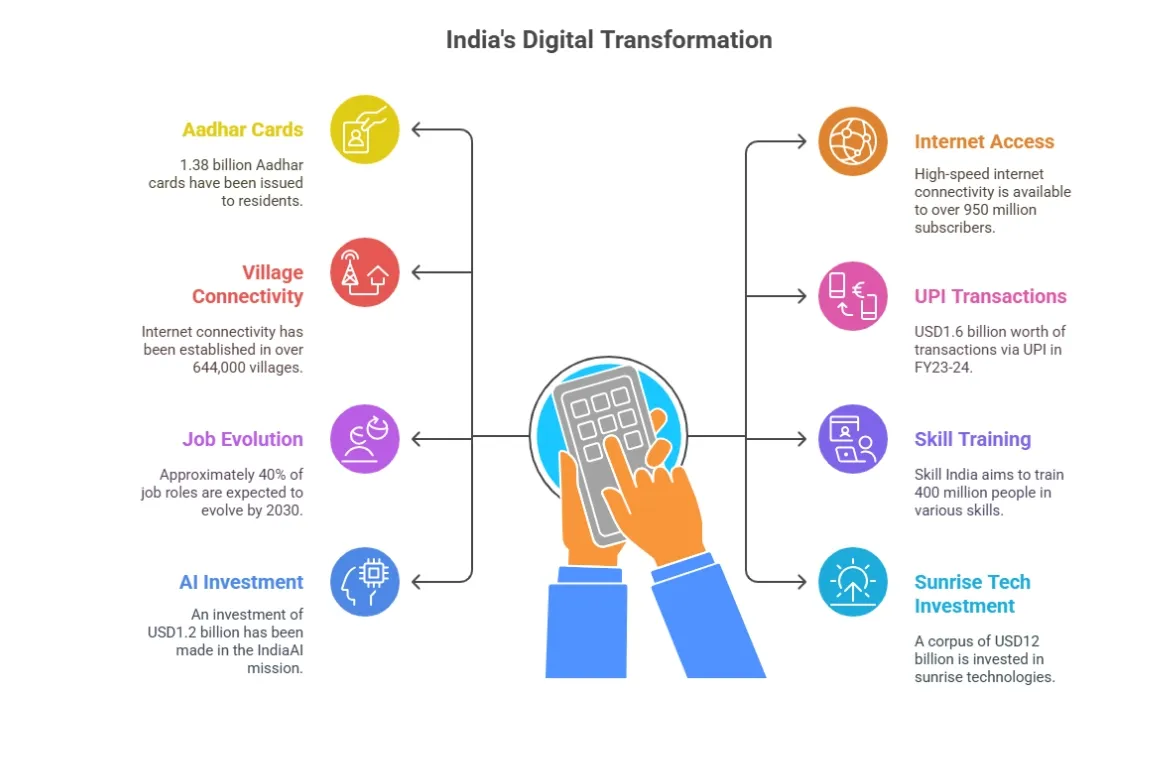Cultivating Digital Mindset in Leaders to Drive Transformation in the Digital Era

The world's digital shift demands businesses to adapt, evolve, and navigate rapid change. Modern business leadership needs a mindset shift, as younger employees increasingly require innovative technology at work.
According to Prime Minister Narendra Modi, India is poised to take on global digital leadership in the next ten years, with the world looking to the country for future digital innovations. Writing in a blog post to celebrate the tenth anniversary of the Digital India initiative, he conveyed his belief that "the subsequent decade will usher in even greater transformation, as we progress from enhancing digital governance within India to leading globally in the digital sphere, moving from a national focus to a worldwide contribution."

Source: India’s Digital Transformation
Why Do Leaders Need a Digital Mindset Today?
Digital innovation has advanced business by six to seven years, and global disruptions have accelerated this progress. Organizations must now adapt to survive as this rise reshapes their operations.
The shift from traditional to digital leadership
Traditional leadership follows a directive approach characterized by hierarchical structures and centralized control. In stark comparison to this, digital leadership strengthens teams through the strategic use of technology. Traditional leadership's hallmark remains its autocratic nature, where leaders delegate responsibilities and maintain decision-making power. Digital leadership represents a significant shift from command-and-control mechanisms toward adaptability, instant communication, and data-driven decision-making.
Digital leaders must possess specific capabilities to guide their organizations through digitalization:
- Strategic vision and technological fluency
- State-of-the-art driven mindset
- People-centred focus
- Comfort with experimentation and calculated risk-taking
How digital mindset drives innovation?
Digital leadership promotes creativity and state-of-the-art solutions that enable new and improved products, services, and business models. Teams can adapt quickly to market changes in environments where experimentation thrives. A digital innovation mindset helps businesses reinvent themselves to meet their clients' and stakeholders' changing needs.
Teams can develop novel ideas and explore innovative solutions that arrange with organizational objectives under digital leaders' guidance. Organizations with strong digital leadership recognize information's value and turn it into useful insights that optimize innovation.
Impact on team performance and agility
Digital leadership affects team dynamics and organizational agility. Research shows that organizational agility and digital capability positively affect digital transformation, while agility plays a vital role in improving digital capabilities. Digital leadership fosters positive team dynamics, enhances collaboration, coordination, and motivation.
Leaders create efficient work processes by making use of digital technology. Teams work more productively and achieve goals faster. Digital leadership increases employee involvement by providing access to digital tools and platforms that improve collaboration and active participation.
Digital leadership promotes a culture of openness, transparency, and continuous improvement in businesses of all types. This approach strengthens employees to contribute to their organization's development and success, increasing satisfaction and loyalty.
Key Traits of a Digital-First Leader
Digital business leaders need specific traits to succeed in our technology-driven world. These characteristics set them apart from traditional leaders and promote an organizational culture that works for modern business needs.
Openness to change and experimentation
Digital leaders actively seek new ideas and changes, creating environments where calculated risks are encouraged and failures become learning opportunities. They establish new industry standards through continuous experimentation rather than following conventional practices.
Comfort with data and digital tools
Strong digital leaders possess sufficient technical knowledge to evaluate opportunities confidently. They transform data into actionable insights that drive strategic decisions and foster a data-informed culture.
Visionary thinking and adaptability
These leaders look beyond current technological limitations, anticipating future possibilities. They stay informed about emerging technologies and adapt swiftly to changes.
Emotional intelligence in digital settings
Despite the technological focus, effective digital leaders excel at interpreting virtual emotional cues and building trust in digital spaces, ensuring successful transformation through strong relationships.
6 Steps to Build a Digital Mindset in Leadership
Organizations need structured approaches and strategic action to build a strong digital mindset in their leadership teams. Leadership culture must systematically embed these approaches to develop the right mindset.
1. Start with a clear digital vision
Digital business leadership starts with a compelling vision that arranges with strategic goals. Leaders should define what digital transformation means for their organization beyond new technology adoption. Their vision should inspire teams by showing the benefits and steps needed to reach digital goals. Strong executive support will overcome political resistance and provide clear direction for data integration work.
2. Simplify the digital world
Good digital leaders know how to make technology available without overwhelming anyone. They choose user-friendly tools that boost productivity and teamwork while making workflows simpler. They assess which technologies serve business goals and remove unnecessary complexity that could slow adoption.
3. Strengthen teams to test and learn
Teams adapt quickly to market changes in environments that welcome experiments. Leaders should create a "test and learn" culture where small trials come before major rollouts. A safe environment will give team members confidence to share ideas, ask questions, and learn from failures.
4. Break down silos and encourage collaboration
Organizational silos block digital transformation success. Breaking silos doesn't mean removing departments - it removes friction that blocks information flow and communication. Teams with different skills and points of view solve problems better and create state-of-the-art solutions.
5. Focus on data integration and literacy
Data integration forms the foundation of digital transformation and gives organizations a complete view of information. Making data available helps all departments access resources for insights and reporting. Data literacy helps everyone turn information into applicable information.
6. Promote a culture of continuous learning
Digital transformation needs ongoing education and skill development. Leaders should create programmes to improve digital literacy and set up mentorship programmes where experienced team members teach others. Recognition of learning achievements motivates continued growth and development.
Embedding Digital Thinking into Organizational Culture
A digital mindset goes beyond developing individual leaders. Companies need to weave digital thinking into their organizational fabric. Success in the digital era demands digital principles that become part of the company's DNA. These principles shape how people work, communicate, and invent new solutions.
Leadership development that lines up with digital goals: Companies must align leadership development with digital transformation goals. Leaders need digital workplace skills, market understanding and strategic thinking. Digital transformation requires true leadership that encourages risk-taking and cross-departmental collaboration. Leaders should champion adaptability, agility and innovation through their actions, setting examples for others.
Building open communication and feedback: Open communication drives successful digital cultures, with transparent companies seeing higher profits. Clear governance enables optimised decision-making and quick responses to opportunities.
Celebrating digital behaviours: Recognition programmes accelerate digital behaviour adoption. Options range from e-gift cards to virtual experiences, combining leadership and peer appreciation. Recognition can be public or private through team meetings, personal conversations or social platforms, making rewards meaningful for each employee's digital transformation contribution.
Conclusion
The digital revolution without doubt changes how organizations operate. A digital mindset has become essential for effective leadership. Digital-first leaders improve team performance and create cultures where experimentation thrives.
Digital transformation has ended up being an experience, not a destination. Organizations that foster digital mindsets among their leaders are ready for long-term success in our technology-driven world. The IIM Calcutta digital leadership programme addresses these challenges and gives leaders the skills needed to direct digital transformation effectively.
Organizations embracing digital thinking at every level will own the future. Those developing digital-first leaders today will definitely gain competitive advantages tomorrow. Their resilient, innovative teams will thrive amid ongoing technological change.
Be a part of change, explore your interests, and choose an exciting business management course.
Key Takeaways
Digital leadership isn't just about adopting new technology it's about fundamentally reshaping how leaders think, operate, and drive transformation in today's rapidly evolving business landscape.
• Digital-first leaders embrace experimentation and data-driven decisions, moving from traditional command-and-control to collaborative, adaptable leadership styles
• Building a digital mindset requires clear vision, simplified technology adoption, and empowering teams to test and learn without fear of failure
• Breaking down organizational silos and fostering cross-functional collaboration are essential for successful digital transformation initiatives
• Embedding digital thinking into company culture through aligned leadership development, open communication, and recognition programmes creates a lasting competitive advantage
• Continuous learning and data literacy must become core organizational capabilities, not optional skills for modern leaders
The most successful organizations recognise that digital transformation is fundamentally a people challenge requiring leaders who can navigate both technological complexity and human dynamics with equal skill.
FAQs
Q1. What are the key traits of a digital-first leader?
Digital-first leaders exhibit openness to change, comfort with data and digital tools, visionary thinking, adaptability, and emotional intelligence in digital settings. They actively seek out new ideas, excel at transforming data into actionable insights, and foster a culture of continuous learning and innovation.
Q2. How does a digital mindset impact team performance and agility?
A digital mindset significantly enhances team performance and agility by fostering more efficient work processes, improving collaboration, and increasing employee engagement. It creates a culture of openness and continuous improvement, leading to increased productivity, innovation, and employee satisfaction.
Q3. What steps can organizations take to build a digital mindset in leadership?
Organizations can build a digital mindset by starting with a clear digital vision, simplifying the digital landscape, empowering teams to test and learn, breaking down silos, focusing on data integration and literacy, and fostering a culture of continuous learning. These steps help embed digital thinking throughout the organization.
Q4. How can digital thinking be embedded into organizational culture?
Embedding digital thinking into organizational culture involves aligning leadership development with digital goals, encouraging open communication and feedback, and recognising and rewarding digital behaviours. This approach helps create an environment where digital principles become deeply integrated into the company's DNA.
Q5. Why is a digital mindset essential for leaders in today's business environment?
A digital mindset is crucial for leaders today because it drives innovation, enables quick adaptation to market changes, and helps organizations leverage emerging technologies effectively. It allows leaders to guide their teams through digital transformation, make data-driven decisions, and create a culture that thrives in the rapidly evolving digital landscape.

TalentSprint
TalentSprint is a leading deep-tech education company. It partners with esteemed academic institutions and global corporations to offer advanced learning programs in deep-tech, management, and emerging technologies. Known for its high-impact programs co-created with think tanks and experts, TalentSprint blends academic expertise with practical industry experience.



